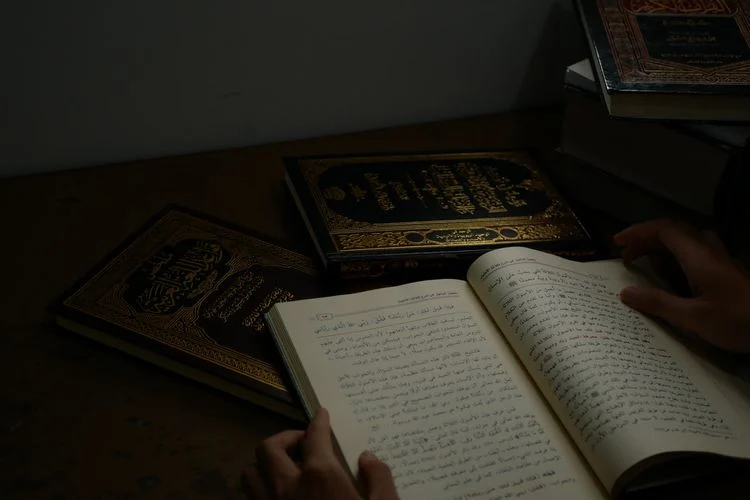Sabil Al-Quran
What Is The Meaning Of Hadith In Islam?
Discovering the essence of Hadith is a journey into the heart of Islamic wisdom and guidance. In Islam, Hadith represents the sayings, actions, and approvals of Prophet Muhammad (peace be upon him), providing us with a practical roadmap to live by Allah’s teachings with clarity and purpose.
Through Sabil Al-Quran, delve into the timeless knowledge embedded in Hadith, enriching your experience of Learning the Quran and daily life with insights straight from the Prophet’s example.
Join us to explore what is hadith in islam, its significance, and how it can inspire a life of faith, compassion, and purpose.
What is Hadith in Islam: Hadith Definition And Meaning
In Islam, a hadees meaning refers to a report or narration about the words, actions, approvals, or characteristics of the Prophet Muhammad (peace be upon him). Hadiths are an essential source of guidance for Muslims, second only to the Quran, because they provide practical examples of how to implement Quran teachings in daily life.
The hadith literature captures everything from the Prophet’s advice on spiritual matters to guidance on social, ethical, and personal behavior, showcasing the wisdom and teachings of The World’s Best Man in Islam, Prophet Muhammad (peace be upon him).
Hadiths are collected in books by scholars, who carefully authenticated them to ensure accuracy and reliability. These narrations help Muslims understand the deeper meanings of the Quran and the proper way to live a life aligned with Islamic principles.

Who Wrote The Hadiths?
The hadiths, or recorded sayings and actions of the Prophet Muhammad (peace be upon him), were collected and compiled by a series of scholars known as muhaddithun (hadith scholars).
These scholars worked diligently, beginning in the decades after the Prophet’s death, to gather, verify, and organize hadiths based on strict criteria to ensure authenticity.
They applied various methods, including examining the narrators’ reliability and the consistency of the narrations. Just as scholars pay attention to the precise articulation of words in the Quran, they also applied similar meticulous methods in the study of the types of madd (elongation of sounds) in the recitation of hadiths, ensuring accuracy in every aspect of transmission.
Key Early Compilers of Hadith
Initially, the companions of the Prophet memorized his sayings and actions and shared them verbally, as the primary mode of preservation. However, as the Muslim community grew, especially beyond Arabia, the need arose to document these narrations to preserve them accurately. By the 2nd and 3rd centuries AH (8th and 9th centuries CE), scholars began formalizing these collections, leading to what are now some of the most respected compilations in Islamic history.
- Imam al-Bukhari (810–870 CE): Imam al-Bukhari is perhaps the most well-known compiler of hadith. He spent over 16 years traveling throughout the Islamic world to gather authentic narrations. Out of around 600,000 hadiths he reviewed, he selected approximately 7,275 based on strict criteria for inclusion in his book, Sahih al-Bukhari, regarded as one of the most authentic hadith collections.
- Imam Muslim (815–875 CE): A contemporary of Imam al-Bukhari, Imam Muslim also compiled a significant collection of hadith, known as Sahih Muslim. He meticulously reviewed narrations to verify their authenticity, eventually selecting around 4,000 hadiths. Sahih Muslim, together with Sahih al-Bukhari, is highly respected and forms the foundation of the Sahihain (the two authentic books of hadith).
- Imam Abu Dawud (817–889 CE): Imam Abu Dawud compiled Sunan Abu Dawud, focusing on hadiths related to Islamic jurisprudence. He included narrations covering various aspects of Islamic law and daily life, including family matters, trade, and worship. His collection is one of the six canonical books in Sunni Islam.
- Imam al-Tirmidhi (824–892 CE): Imam al-Tirmidhi’s compilation, Jami’ al-Tirmidhi, is known for classifying hadiths by their level of authenticity. He also included commentary explaining how each hadith was applied in Islamic law. His work provides insight into how scholars of his time approached the study of hadith.
- Imam al-Nasa’i (829–915 CE): Sunan al-Nasa’i, compiled by Imam al-Nasa’i, is another key hadith collection. Known for his attention to detail, Imam al-Nasa’i included fewer hadiths but ensured their high quality and reliability.
- Imam Ibn Majah (824–887 CE): Sunan Ibn Majah completes the six major books of Sunni hadith. Ibn Majah’s collection included some narrations not found in other collections, which adds diversity to the hadith corpus.
Method of Collection and Verification
These scholars developed rigorous methods to authenticate hadiths, focusing on the reliability of each narrator in the chain (known as isnad) and the content of the narration itself (known as matn).
They assessed the integrity, memory, and character of narrators and often cross-referenced narrations to confirm consistency. This process established a scientific approach to verifying hadiths, leading to the creation of classifications like sahih (authentic), hasan (good), and da’if (weak) based on reliability.

Importance of Early Written Collections
While the early generations primarily relied on memorization, written compilations soon became necessary to protect the hadiths from alterations or loss.
Some early companions and followers of the Prophet began documenting hadiths in notebooks, known as sahifahs, which served as references for later scholars.
These hadith collections have become foundational texts in Islam, shaping Islamic law, ethics, and daily life.
Their rigorous preservation underscores the importance of the Prophet Muhammad’s teachings in the Islamic faith, much like the dedication and precision demonstrated by the best Quranic reciters who ensure the flawless transmission of the Quran through generations.

Where Did Hadith Come From?
Hadiths originate from the sayings, actions, approvals, and personal attributes of the Prophet Muhammad (peace be upon him). They were initially shared orally by his close companions, who observed him closely throughout his life. The companions took great care to preserve the Prophet’s words and actions accurately, and they often narrated them to their families, students, and the growing Muslim community.
Stages of Hadith Preservation
- Oral Transmission by the Companions: During the Prophet’s life, his companions memorized and shared his words and actions as guidance. They regarded his behavior as exemplary, often asking questions and listening carefully to his teachings on various issues, from worship to interpersonal conduct.
- Documentation in the Form of Sahifahs: Although the primary method of preservation was through memorization, some companions began documenting hadiths even in the Prophet’s time, in personal notebooks known as sahifahs. For example, Sahifah Hammam ibn Munabbih is a well-known early written collection by one of the companions’ students.
- The Tabi’un (Successors) Period: After the passing of the Prophet and his companions, their students, known as the Tabi’un (Successors), continued the tradition of transmitting and recording hadiths. This generation placed even greater emphasis on safeguarding these teachings, as Islam expanded into new regions. They compiled more comprehensive notes and began to establish standards for evaluating narrators’ reliability.
- Formal Compilation by Scholars (2nd and 3rd Centuries AH): By the second and third centuries AH (approximately the 8th and 9th centuries CE), scholars systematically gathered, authenticated, and organized the hadiths into official collections. These scholars traveled widely to meet reliable narrators, verify chains of transmission, and examine each narration’s content and context.
Classification and Verification
The process of verifying hadiths involved examining both the isnad (chain of narrators) and matn (text of the narration). Scholars developed a system to classify hadiths based on the narrators’ trustworthiness, memory, and consistency, which allowed Muslims to rely confidently on hadiths for guidance in faith and practice.
Significance
These collections serve as essential resources for understanding Islam’s teachings, complementing the Quran by providing practical examples from the Prophet’s life on how to live according to divine guidance. The hadiths continue to be invaluable in Islamic scholarship, law, and daily life, offering insights into how Muslims can embody the principles of Islam.
Is There Any Debate Going On About The Authenticity Of The Hadith Books Of Islam?
Yes, there has been considerable debate and discussion among scholars and historians, both historically and in modern times, regarding the authenticity of some hadith collections in Islam. Here’s an overview of the key points in these debates:
1. Early Muslim Scholarship on Hadith Authenticity
- Classical Hadith Verification: Muslim scholars have historically recognized the need to verify hadiths. By the second and third centuries AH (8th and 9th centuries CE), scholars like Imam al-Bukhari and Imam Muslim developed rigorous methods to collect and verify hadiths. They analyzed each hadith’s isnad (chain of transmission) and matn (text) to determine authenticity, which resulted in highly regarded collections known as the Sahihs.
- Hadith Classification: Hadiths were classified into categories like sahih (authentic), hasan (good), da’if (weak), and mawdu’ (fabricated) based on the reliability of their chains of transmission. Scholars established criteria to differentiate between strong and weak narrations, which led to a consensus on the authenticity of many hadiths.
2. Modern Scholarly Debates
- Orientalist Critique: Some Western historians and Orientalist scholars in the 19th and 20th centuries questioned the authenticity of hadith collections, suggesting that some narrations might have been influenced by political or social factors after the Prophet’s lifetime. They argue that some hadiths might reflect the needs and issues of later Islamic communities rather than the direct teachings of the Prophet.
- Historical-Critical Method: Modern historians sometimes use the historical-critical method, a technique to assess the historical authenticity of religious texts, to question the timing and reliability of certain hadith transmissions. Scholars in this approach analyze the historical context in which these narrations were documented to consider the possibility of external influences.
3. Intra-Islamic Perspectives
- Differing Schools of Thought: There are differences between Sunni and Shia Islam regarding certain hadiths and narrators. For example, while Sunnis often regard the Sahih collections of Bukhari and Muslim as highly reliable, Shia scholars give priority to hadiths narrated through the Prophet’s family and compiled in collections like Al-Kafi.
- “Quran-Only” Muslims: A small minority within the Muslim community, known as “Quranists,” argue that only the Quran should be used as the source of guidance, viewing hadith collections as fallible and prone to error. They believe that focusing solely on the Quran eliminates the risk of following unreliable teachings.
4. Ongoing Scholarship in the Muslim World
- Re-examination of Chains and Texts: Some modern Muslim scholars continue to analyze hadith chains and texts, especially weaker or controversial hadiths, to better understand their authenticity and relevance. Advanced technologies and newly accessible manuscripts also allow for new perspectives on these texts.
- Debates on Weak or Fabricated Hadiths: There is an ongoing effort among scholars to clarify which hadiths are universally accepted and which are contested or weak. This has led to updated compilations that categorize and comment on narrations’ reliability and applicability in today’s world.
5. Significance in Islamic Practice
- Central Role of Major Hadith Collections: Despite debates, the core collections like Sahih al-Bukhari and Sahih Muslim remain central to Islamic practice and are widely accepted by the majority of Muslims.
- Ongoing Scholarship and Understanding: Islamic scholarship traditionally embraces rigorous examination, and even classical scholars encouraged study and re-evaluation. This open approach enables continuous refinement and understanding of hadith science while maintaining the integrity of Islamic teachings.
while there are debates regarding certain hadiths, the majority of Muslims regard authentic hadith collections as reliable sources of guidance. Scholars’ efforts to analyze, verify, and contextualize hadiths contribute to a balanced approach that values both preservation and critical examination of these narrations.

How Is It Verified If A Hadith Is Authentic/Not Authentic or Weak/Strong?
In Islam, the authenticity of a hadith is determined by a rigorous method called ilm al-hadith, or the “science of hadith.” This science involves systematic analysis and classification based on specific criteria developed by early Muslim scholars.
The process focuses on two main aspects: the isnad (chain of transmission) and the matn (content of the text). Here’s an overview of the key steps involved in verifying if a hadith is authentic, weak, or fabricated:
1. Evaluating the Isnad (Chain of Transmission)
- Reliability of Narrators: Scholars examine each narrator in the chain to ensure they were reliable, trustworthy, and known for their good character and memory. This includes examining their personal conduct, reputation, and consistency in reporting.
- Connection of the Chain: Each narrator must have directly received the narration from their predecessor without any gaps in the chain. This unbroken chain is essential to establish the authenticity of the hadith.
- Validation of Sources: Scholars study the sources of narrations, looking into the historical and geographical context to ensure that the narrators could have actually met and transmitted the hadith.
2. Examining the Matn (Content of the Hadith)
- Consistency with the Quran: The content of the hadith is examined to ensure it aligns with the Quran, which is the primary and unquestionable source in Islam. Any hadith that contradicts the Quran is considered weak or rejected.
- Absence of Contradictions: The hadith must not contradict other stronger or more widely accepted hadiths on similar topics. If it does, it may be classified as weak.
- Clarity and Language: The wording of the hadith is analyzed to ensure it is not excessively unusual or contrary to the Prophet’s known style and way of teaching. Hadiths with unusual or exaggerated language are often scrutinized further.
3. Categories of Hadith Based on Authenticity
- Sahih (Authentic): A hadith with a reliable, unbroken chain of trustworthy narrators, and no contradictions or flaws in the content.
- Hasan (Good): A hadith with a generally reliable chain but may have minor issues in narrators’ memory or minor gaps. It is considered acceptable for reference but not at the same level as sahih.
- Da’if (Weak): A hadith with issues in the chain or content, such as gaps in the chain, unreliable narrators, or inconsistencies. Weak hadiths are generally avoided in forming beliefs or major rulings but may be used for encouragement in personal conduct.
- Mawdu’ (Fabricated): A hadith deemed false due to known forgery or serious contradictions. Fabricated hadiths are completely rejected and are not used in any Islamic teachings or practices.
4. Methodologies and Major Scholars in Hadith Science
- Hadith Collections and Verifiers: Early scholars like Imam Bukhari, Imam Muslim, and others compiled authentic hadiths after extensive verification. They used stringent methods to ensure their collections contained only authentic narrations.
- Books of Rijal (Men of Narration): Scholars also compiled detailed biographies of narrators in books known as kutub al-rijal. These works document narrators’ lives, reliability, and memory, and serve as references for verifying narrators’ credibility.
5. Ongoing Verification by Scholars
- Continuous Re-evaluation: Hadith scholars today continue to study and re-evaluate narrations using modern methodologies and historical analysis. With access to advanced resources and preserved manuscripts, the verification process is an ongoing scholarly pursuit.
The meticulous science of hadith verification ensures that Muslims can distinguish between authentic, weak, and fabricated narrations. It safeguards the integrity of the Prophet Muhammad’s ﷺ teachings and protects the faith from distortions. As Islamic scholars emphasize, a person who deliberately distorts or fabricates hadith1 for personal motives commits a grave sin, for it is not permissible for a Muslim to attribute to the Prophet ﷺ words or actions that were never authentically reported.

What Is The Importance Of Hadith In Islam?
The Hadith holds significant importance in Islam as it complements and supplements the Quran. Here’s why:
The Significance of Hadith:
- Explanation of the Quran: Hadith provides detailed context and explanations for the verses in the Quran, helping Muslims understand and implement the teachings more effectively.
- Guidance on Daily Life: It covers various aspects of daily life, including prayer, social interactions, and ethical conduct, providing a practical framework for living a life in accordance with Islamic principles.
- Role in Islamic Jurisprudence: Hadith is a fundamental source of Islamic law (Sharia), alongside the Quran. Scholars use it to derive legal rulings and ethical guidelines.
- Historical Context: Hadith preserves the sayings, actions, and approvals of the Prophet Muhammad (peace be upon him), offering insights into his life and the early Islamic community.
- Moral and Spiritual Lessons: It encapsulates the Prophet’s teachings on morality, spirituality, and character development, serving as a guide for personal growth and piety.
Additionally, you will learn The Benefits of Quran Recitation and the Basic Rules of Recitation of Quran, empowering you to recite with clarity and understanding, while benefiting from the spiritual rewards of proper recitation.
By embracing the teachings of the Hadith, we gain profound insights into the Prophet Muhammad’s (PBUH) exemplary life and actions, guiding us towards righteousness and spiritual fulfillment. At Sabil Al-Quran, we invite you to embark on a journey of knowledge and faith, exploring the depths of the Quran to enrich your spiritual and practical life. Through our Islamic Studies Online Course, you will gain a deeper understanding of the Quran’s teachings, enhancing both your connection to the divine and your everyday experiences with the guidance of Islamic principles.
Conclusion: The Meaning Of Hadith In Islam
The Hadith remains one of the most essential sources of guidance in Islam, second only to the Quran. It provides not only an explanation of hadith principles but also serves as a living example of how the Prophet Muhammad (peace be upon him) practiced and applied divine teachings in daily life. For Muslims, understanding what is a hadith in Islam is crucial, as it shapes their worship, ethics, and character.
Sabil Al Quran offers a variety of courses designed to enhance your Quranic and Islamic knowledge:
- Islamic Studies Course: A comprehensive course covering the core principles of Islam, including Aqeedah, Fiqh, and Seerah.
- Online Quran Recitation Course: Focuses on correct pronunciation and fluency in reciting the Quran with clarity and accuracy.
- Quran Memorization Course: A structured course designed to help students memorize the Quran efficiently and with proper guidance.
- Online Ijazah Course: Offers certification in Quranic recitation, enabling students to become qualified teachers of the Quran.
- Online Arabic Language Courses: Teaches Arabic language skills to better understand the Quran and Hadith in their original form.
- Tajweed Rules Course: Provides in-depth training on Tajweed, helping students master the proper rules for Quranic recitation.
Join us today and deepen your connection to the wisdom that has shaped Islamic civilization for centuries.
FAQS: Hadees Meaning in Islam
How is a Hadith different from the Quran?
The Quran is the literal word of God as revealed to the Prophet Muhammad, while Hadith consists of the Prophet’s sayings and actions. The Quran is considered the primary source of Islamic law, whereas Hadith provides context and elaboration on the Quranic teachings.
How are Hadiths classified?
Hadiths are classified based on their authenticity into several categories, including:
Sahih (authentic): Reliable and accurate.
Da’if (weak): Has issues regarding its chain of transmission or content.
Hasan (good): Generally accepted but may have slight doubts in authenticity.
Mutawatir: Narrated by a large number of people, making it highly credible.
What is the significance of Hadith in Islamic practices?
Hadith plays a crucial role in Islamic practices as it provides detailed guidance on various aspects of life, including worship, morality, and personal conduct. It helps Muslims understand how to implement Quranic teachings in daily life and establishes the Sunnah, which is the tradition of the Prophet.
How can one study Hadith?
Studying Hadith can be done through various resources, such as:
Hadith Collections: Referencing major collections like Sahih Bukhari, Sahih Muslim, and others.
Classes and Lectures: Enrolling in Islamic studies programs at mosques or educational institutions.
Online Resources: Utilizing websites and platforms dedicated to Islamic knowledge that offer Hadith studies and commentary.
- https://www.dar-alifta.org/ar/fatwa/details/16577/%D8%A7%D9%84%D8%AA%D8%AD%D8%B0%D9%8A%D8%B1-%D9%85%D9%86-%D8%AA%D8%AD%D8%B1%D9%8A%D9%81-%D8%A7%D9%84%D8%A3%D8%AD%D8%A7%D8%AF%D9%8A%D8%AB-%D8%A7%D9%84%D9%86%D8%A8%D9%88%D9%8A%D8%A9-%D8%A7%D9%84%D8%B4%D8%B1%D9%8A%D9%81%D8%A9 ↩︎

